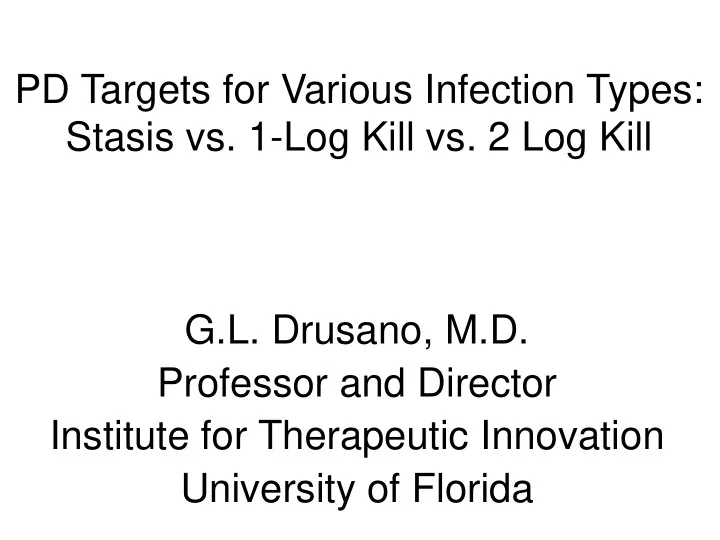

PD Targets for Various Infection Types: Stasis vs. 1-Log Kill vs. 2 Log Kill G.L. Drusano, M.D. Professor and Director Institute for Therapeutic Innovation University of Florida
PD Targets – Nosocomial Pneumonia • To have insight into appropriate cell kill targets in preclinical models, it is necessary to link measures of an appropriate exposure index to bacterial cell kill and then to bridge to man by looking at that same index with regard to outcomes seen in patients • This was done previously in a paper in CID • These presentations (Paul and I) are an update; but first, the oldie but goodie
PD Targets – Nosocomial Pneumonia • Nosocomial pneumonia is arguably the most difficult to treat common infection in the ICU • It is a source of major morbidity and is frequently fatal • It also attended by the densest bacterial burdens • As will be seen in a few slides, the minimal burden to qualify for the diagnosis is 10 4 CFU/ml in BAL (10 5.5 CFU/ml corrected for dilution)
PD Targets – Nosocomial Pneumonia • Let us first look at a murine model of nosocomial pneumonia using Pseudomonas aeruginosa as the challenge organism
PD Targets – Nosocomial Pneumonia The Model Applied to All the Data Simultaneously
PD Targets – Nosocomial Pneumonia
Levofloxacin Activity in Murine Pseudomonas Pneumonia
Levofloxacin PK in a Murine Pneumonia Model
Levofloxacin Targets in Mouse and Man in P. aeruginosa Murine Pneumonia and HAP Mouse Pneumonia * f AUC/MIC Ratio Stasis 15.9 1 Log10 (CFU/g) Kill 40.2 2 Log10 (CFU/g) Kill 56.5 3 Log10 (CFU/g) Kill 164 HABP f AUC/MIC Ratio and Response Ciprofloxacin (retrospective) ** 75.0 (>75 – 80.4% response; <75 – 44% response) Levofloxacin (prospective) *** 62.0 (>62 – 90% response; <62 – 43% response) *Louie A, C Fregeau, W Liu, R Kulawy, GL Drusano. AAC. 2009;53:3325-3330 **Forrest A, DE Nix, CH Ballow et al. AAC. 1993;37:1073-1081 ***Drusano GL, SL Preston, C Fowler, M Corrado, B Weisinger, J Kahn. JID. 2004;189:1590-1597
PD Targets – Nosocomial Pneumonia So, why is nosocomial pneumonia hard to treat?
Granulocyte Kill of P. aeruginosa
PD Targets – Nosocomial Pneumonia Fit of a Michaelis-Menten Model to Saturation of Granulocytes the Data This means that the minimum bacterial cell kill to unsaturate the granulocytes is a 2 Log 10 (CFU/g) kill (and 3 Logs is better) Antimicrob Agents Chemother 2011;55:2693-2695
PD Targets – Nosocomial Pneumonia • In the next experiment, mice were neutrophil replete and had P. aeruginosa pneumonia • There were 18 active cohorts and 2 cohorts of no- treatment controls • Plazomicin was administered in a dose ranging fashion with “humanized” dosing • 2 hour treatment delay; after 24 h of Rx (h 26) plazomicin administration stopped • At this point the drug concentration in ELF was 0.25 x MIC • The final cohorts were sacrificed at h 50
PD Targets – Nosocomial Pneumonia These three differential equations account for the drug in the mouse both in the plasma as well as in the Epithelial Lining Fluid (ELF) This equation accounts for bacterial kill by the antibiotic This differential equation accounts for bacterial growth and bacterial death by: 1) drug kill and 2) Granulocyte kill
Therapy of Nosocomial Pneumonia 1.5 Log 10 (CFU/g) bacterial kill by granulocytes over 24 hours without drug attained by unsaturating the granulocytes with plazomicin Rx J Infect Dis 2014;210:1319-1324
PD Targets – Nosocomial Pneumonia • Plazomicin clearly has a major effect of the bacterial burden • At the end of 24 hours after therapy initiation, virtually no Plazomicin remains. • When bacterial burdens are approximately 10 6 CFU/g or above, counts are either steady or rise slightly over the next 24 hours. • At higher drug exposures colony counts decline below saturation point and granulocytes kill more organisms over hrs 26-50
Granulocytes and Chemotherapy: Optimizing Outcome Why is this important? To meet the definition of ventilator-requiring hospital-acquired bacterial pneumonia (VRHABP), 10 4 CFU/ml in broncoalveolar lavage (BAL) fluid are required. Previous data from patients * demonstrates that BAL results in a 30-100 fold dilution. This is approximately a 1.5-2.0 Log 10 (CFU/ml) dilution, meaning that the lowest burden qualifying as documented pneumonia is really 3x10 5 to 10 6 CFU/ml. Zaccard et al + looked at bilateral BAL in patients with suspected VRHABP. There were 134 samples from patients with P. aeruginosa , Enterobacter spp, K. pneumonia , Acinetobacter spp and Serratia marcescens Correcting for dilution (not in the original paper), the burdens distributed as below: >3x10 5 -<3x10 6 >3x10 6 -<3x10 7 >3x10 7 -1x10 8 Total 49 (36.6%) 50 (37.3%) 35 (26.1%) 134 (100%) Circa 63% of patients have burdens that exceed the half-saturation point (K m ) of granulocytes at baseline! * Antimicrob Agents Chemother. 2011;55:1606-1610 + J Clin Microbiol. 2009;47:2918-2924
PD Targets – Nosocomial Pneumonia • So, what Log kill do we need to achieve ? 1 Log kill achieves near maximal granulocyte unsaturation circa 36.6% of the time 2 Log kill achieves near maximal granulocyte unsaturation circa 62.7% of the time 3 Log kill achieves near maximal granulocyte unsaturation circa 100% of the time • But 3 Log kill is very hard to achieve
PD Targets – Nosocomial Pneumonia • So, Paul is always telling me “DON’T THROW OUT THE BABY WITH THE BATH WATER!!!” • And I agree with the sentiment • There is a reasonable amount of evidence that a 2 Log10 (CFU/g) bacterial kill is helpful for achieving good outcomes in this pathologic process • If a drug was being developed for MDR pathogens that could not achieve this target, would I reject it? – NO • But, we should recognize what is a worthy target • Can we get patients better faster? • Do we need to think about combination therapy? • Now, on to Paul
Thank You for Your Attention!
Recommend
More recommend